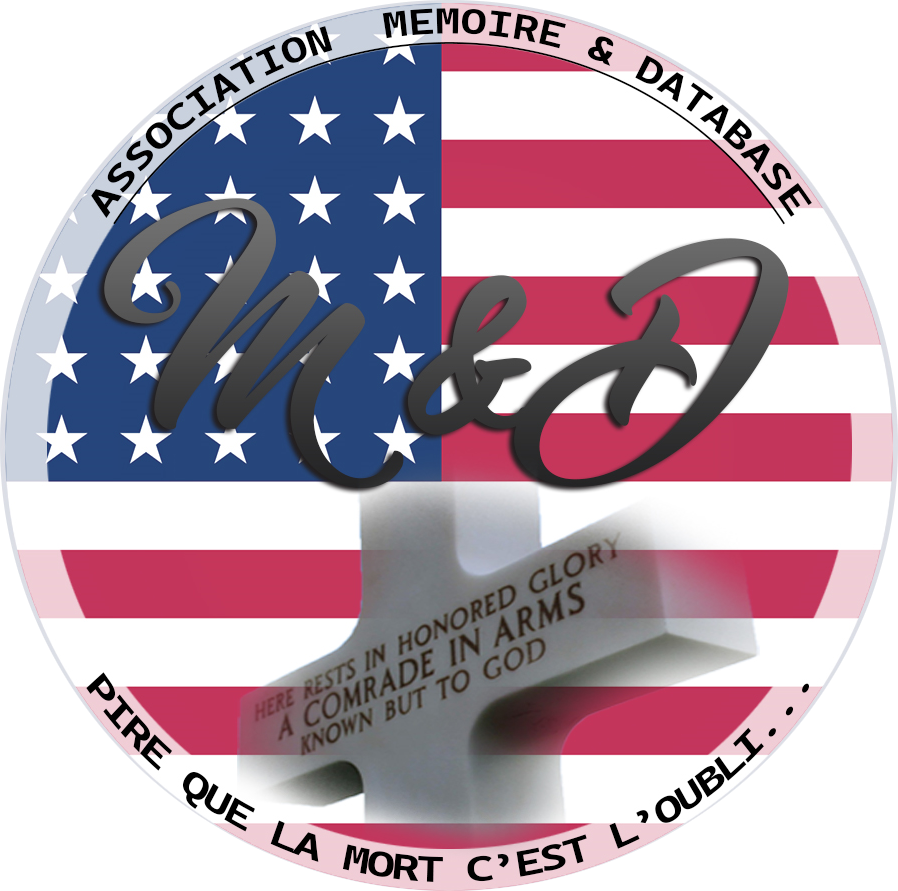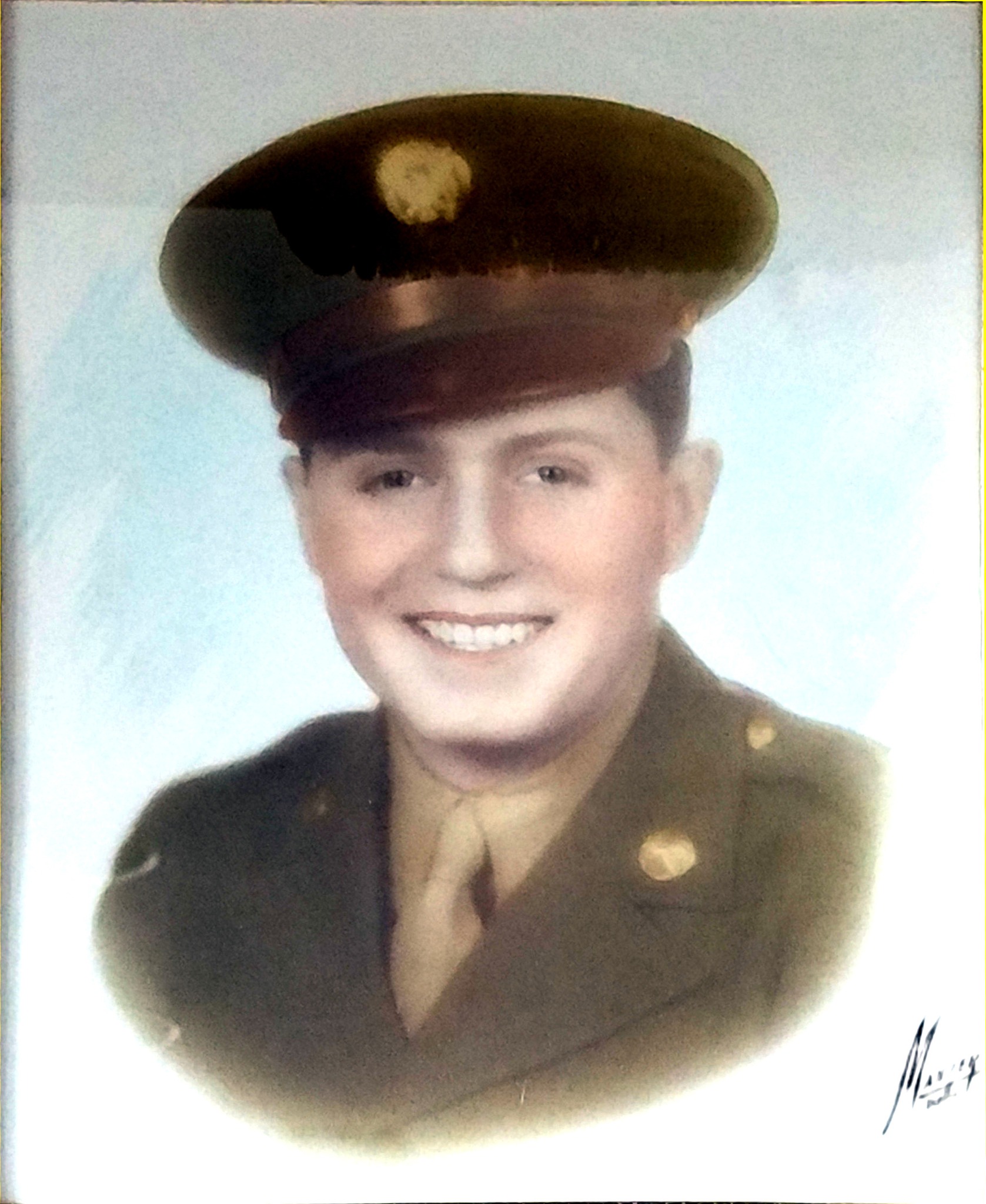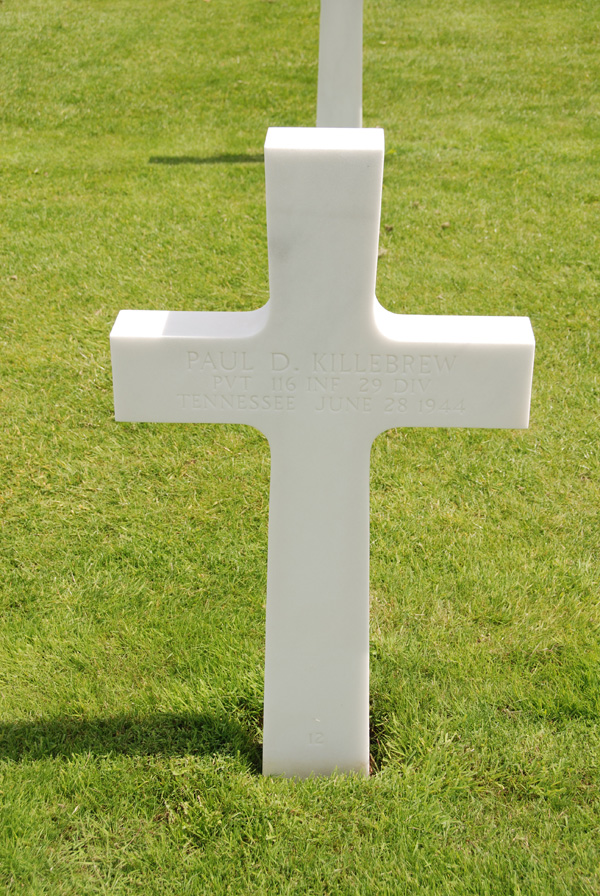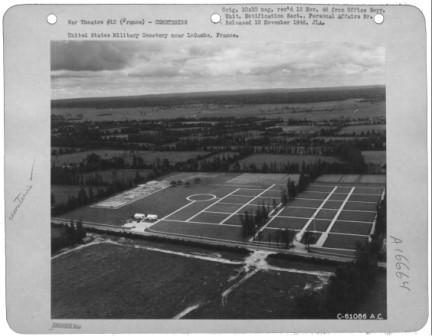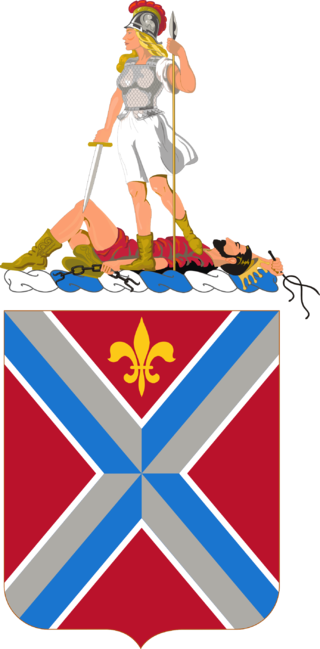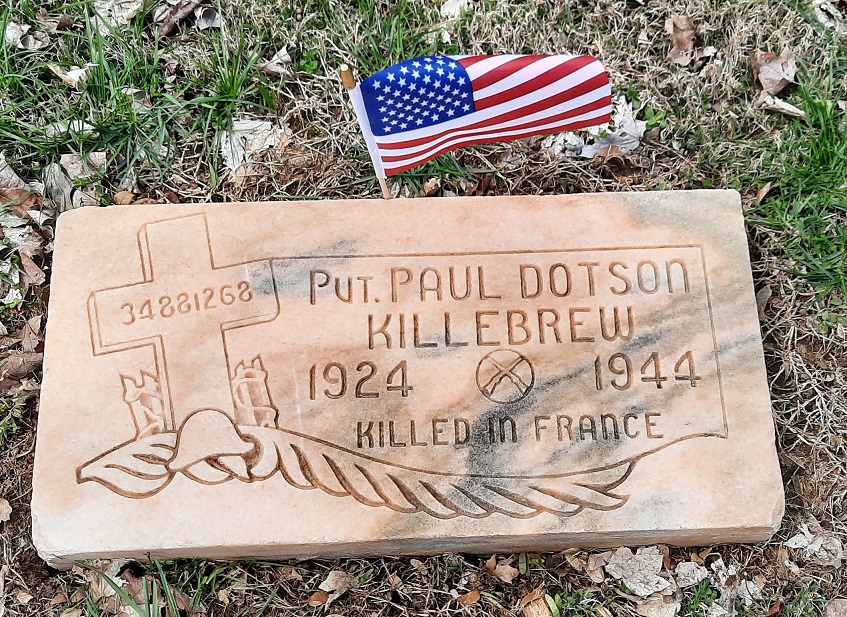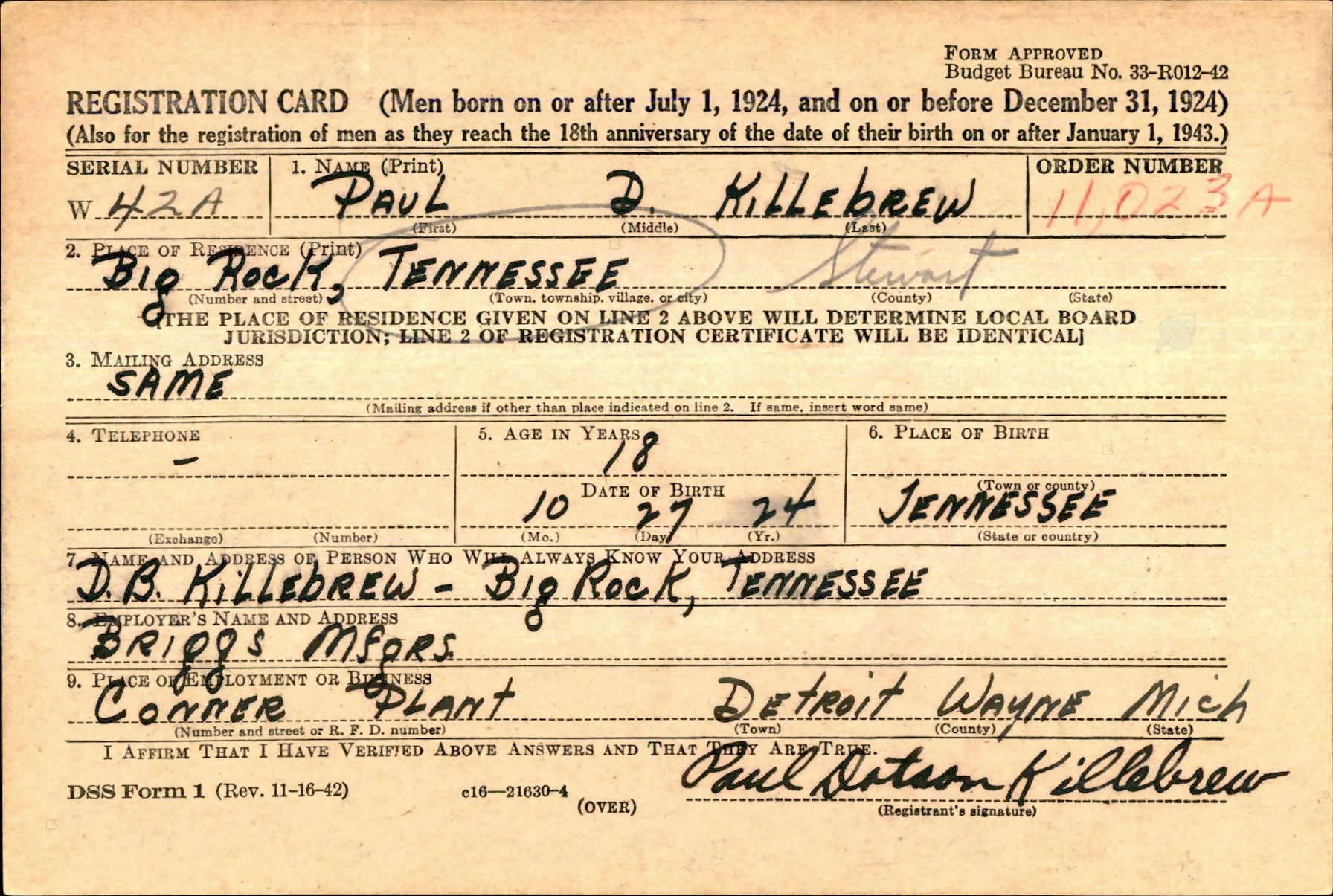|
Paul Dotson KILLEBREW
| ||||||||||||||||||||||||
|---|---|---|---|---|---|---|---|---|---|---|---|---|---|---|---|---|---|---|---|---|---|---|---|---|
|
Source : Jana KILLEBREW (Nièce) (Ellen Marchese)
| ||||||||||||||||||||||||
| NUMERO DE SERVICE | 34881268 | |||||||||||||||||||||||
| AGE | 19 ans | |||||||||||||||||||||||
| DATE DE NAISSANCE | 27 octobre 1924 Big Rock, Stewart County, TENNESSEE | |||||||||||||||||||||||
| ÉTAT D’ENRÔLEMENT | TENNESSEE | |||||||||||||||||||||||
| FAMILLE |
Parents : David Brunson & Cynthia Frances Parker KILLEBREW Frères : Fred Parker KILLEBREW | |||||||||||||||||||||||
| GRADE | Private | |||||||||||||||||||||||
| FONCTION | Infantry Man | |||||||||||||||||||||||
| PROFESSION AVANT INCORPORATION | Semiskilled occupations in building of aircraft |  | ||||||||||||||||||||||
| DATE D'INCORPORATION | 24 juillet 1943 Fort Oglethorpe GEORGIA | |||||||||||||||||||||||
| COMPANY | Company G | |||||||||||||||||||||||
| BATTALION | 3rd Battalion | |||||||||||||||||||||||
| REGIMENT | 116th Infantry Regiment | |||||||||||||||||||||||
| DIVISION | 29th Infantry Division | |||||||||||||||||||||||
| DATE DU DECES | 28 juin 1944 |
Source : Mike & Bushy Hartman | ||||||||||||||||||||||
| STATUT | KIA | |||||||||||||||||||||||
| LIEU DU DECES | Secteur de St Lo | |||||||||||||||||||||||
| CIMETIERE PROVISOIRE |
CIMETIERE PROVISOIRE de La Cambe N°3539
| |||||||||||||||||||||||
| CIMETIERE | NORMANDY AMERICAN CEMETERY de Colleville | |||||||||||||||||||||||
| TOMBE |
| |||||||||||||||||||||||
| DECORATION |
| |||||||||||||||||||||||
| ||||||||||||||||||||||||
| HISTOIRE | ||||||||||||||||||||||||
|
Paul Dotson Killebrew est né le 27 octobre 1924 à Big Rock, comté de Stewart, Tennessee, fils de David Brunson Killebrew et de Cynthia Frances Parker. La famille vivait dans le comté de Stewart, où son père était propriétaire d'un magasin en 1930 et fermier en 1940. Paul avait un frère. Il est diplômé de Big Rock High School dans le comté de Stewart. Son père tenait un magasin et cultivait. Le 19 décembre 1942, il s'inscrit pour son incorporation dans le comté de Wayne, Michigan. À cette époque, il était employé par l'usine de fabrication Briggs à Detroit. Paul travaillait peut-être dans la fabrication d'avions lorsqu'il a été enrôlé en octobre 1943. Le 24 juillet 1943, il s'enrôle dans l'armée à Ft. Oglethorpe, Géorgie. Il était soldat dans le 116th Infantry Regiment, 29th Infantry Division. En préparation de l' invasion de la Normandie , le régiment a participé à des exercices de répétition d'invasion, utilisant des péniches de débarquement, des véhicules, du personnel et des péniches d'assaut. | ||||||||||||||||||||||||
Pour l'invasion, le régiment faisait partie de la Force O, la force d'assaut initiale. Le 3 juin 1944, le régiment s'embarque pour la Normandie depuis Weymouth. L'opération est lancée le 6 juin 1944. Le 11 juin, le 116th est retiré dans la réserve afin de se réorganiser en raison des pertes du jour J. Ils avancèrent le 14 juin. Entre le 7 juin et le 19 juillet, 438 hommes du régiment furent tués, 2 040 blessés et 38 disparus, pour un total de 2 516 victimes. Le soldat Paul D. Killebrew a été tué au combat le 28 juin 1944. |
Source : Terry Minton | |||||||||||||||||||||||
|
Source : Fold 3
| ||||||||||||||||||||||||
|
Il est enterré au cimetière américain de Normandie, Colleville-sur-Mer, France. Une pierre commémorative se trouve dans le terrain de la famille Killebrew, au cimetière Powell, LaFayette, comté chrétien, Kentucky. | ||||||||||||||||||||||||
Activated/Activé |
Normandy/Normandie |
| 3 Feb 1941 | Days of Combat/Jour de Combat 242 |
| Casualties/Victimes 20 620 | |
Entered Combat/Entré au combat |
|
| 6 Jun1944 D-Day | |
|
Commanding Generals/Commandants généraux Maj. Gen. Milton A. Reckord (Feb 41 - Jan 42) |
Campaigns/CampagnesNormandy (6 Jun 44 - 24 Jul 44)
|
PLAN DE ROUTE DE LA CAMPAGNE - CAMPAIGN ROUTE MAP |
|
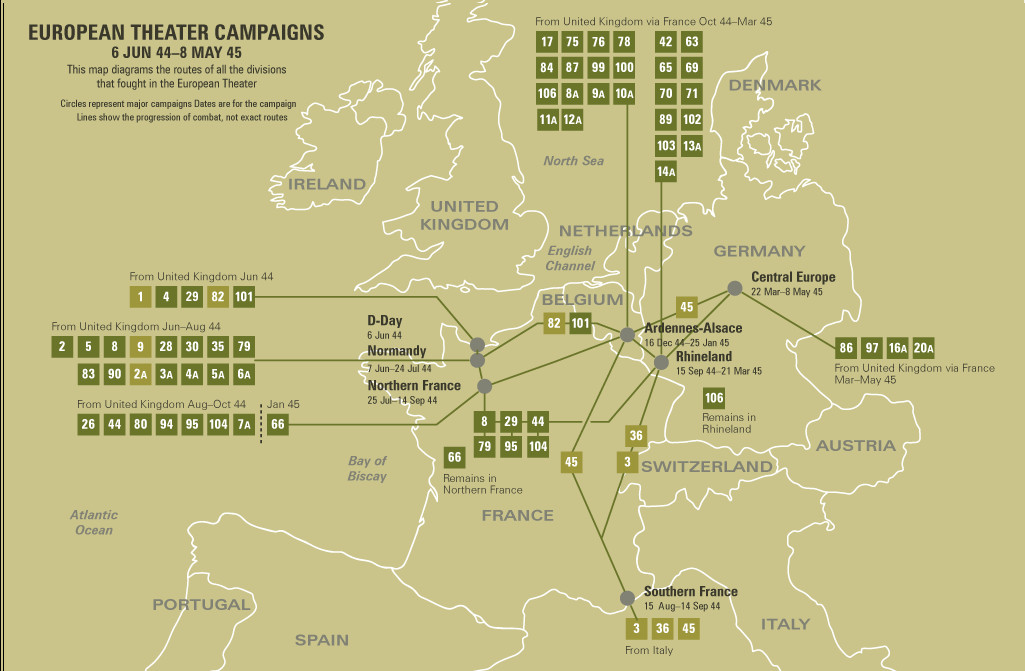 |
|
DIVISION CHRONICLEThe 29th Infantry Division trained in Scotland and England for the crosschannel invasion, October 1942-June 1944. Teamed with the 1st Division, a regiment of the 29th (116th Infantry) was in the first assault wave to hit the beaches at Normandy on D-day, 6 June 1944. Landing on Omaha Beach on the same day in the face of intense enemy fire, the Division soon secured the bluff tops and occupied Isigny, 9 June. The Division cut across the Elle River and advanced slowly toward St. Lo, fighting bitterly in the Normandy hedge rows. After taking St. Lo, 18 July 1944, the Division joined in the battle for Vire, capturing that strongly held city, 7 August. Turning west, the 29th took part in the assault on Brest, 25 August-18 September 1944. After a short rest, the Division moved to defensive positions along the Teveren-Geilenkirchen line in Germany and maintained those positions through October. (In mid-October the 116th Infantry took part in the fighting at the Aachen Gap.) On 16 November the Division began its drive to the Roer, blasting its way through Siersdorf, Setterich, Durboslar, and Bettendorf, and reaching the Roer by the end of the month. Heavy fighting reduced Julich Sportplatz and the Hasenfeld Gut, 8 December. From 8 December 1944 to 23 February 1945, the Division held defensive positions along the Roer and prepared for the offensive. The attack jumped off across the Roer, 23 February, and carried the Division through Julich, Broich, Immerath, and Titz, to Munchen-Gladbach, 1 March 1945. The Division was out of combat in March. In early April the 116th Infantry helped mop up in the Ruhr area. On 19 April 1945 the Division pushed to the Elbe and held defensive positions until 4 May. Meanwhile, the 175th Infantry cleared the Klotze Forest. After VE-day, the Division was on military government duty in the Bremen enclave. |
CHRONIQUE DE DIVISIONLa 29th Infantry Division s'entraîna en Ecosse et en Angleterre pour l'invasion crosschannel, d'octobre 1942 à juin 1944. En équipe avec la 1st Division, un régiment du 29th (116th Infantry) se trouvait dans la première vague d'assaut pour frapper les plages de Normandie. Le 6 juin 1944, débarquant à Omaha Beach, le même jour, face à un feu nourri de l'ennemi, la division s'empara bientôt des falaises et occupa Isigny, le 9 juin. La Division traversa la rivière Elle et s'avança lentement vers Saint-Lô, se battant amèrement dans les rangées de haies de Normandie. Après avoir pris St. Lo, le 18 juillet 1944, la division se joignit à la bataille de Vire pour s'emparer de cette ville fortement occupée, le 7 août. Tournant vers l'ouest, le 29 a pris part à l'assaut sur Brest, 25 août-18 septembre 1944. Après un court repos, la division a déménagé à des positions défensives le long de la ligne Teveren-Geilenkirchen en Allemagne et a maintenu ces positions jusqu'en octobre. (À la mi-octobre, le 116e régiment d'infanterie prit part aux combats à Aix-la-Chapelle.) Le 16 novembre, la division commença sa route vers la Roer, traversant Siersdorf, Setterich, Durboslar et Bettendorf, et atteignant la Roer par la fin du mois. Les combats intenses ont réduit Julich Sportplatz et le Hasenfeld Gut, le 8 décembre. Du 8 décembre 1944 au 23 février 1945, la division occupe des positions défensives le long de la Roer et se prépare à l'offensive. L'attaque a sauté à travers le Roer, le 23 février, et a porté la Division par l'intermédiaire de Julich, Broich, Immerath, et Titz, à Munchen-Gladbach, le 1er mars 1945. La Division était hors combat en mars. Au début du mois d'avril, le 116th Infantry a aidé à nettoyer la région de la Ruhr. Le 19 avril 1945, la division pousse vers l'Elbe et occupe des positions défensives jusqu'au 4 mai. Pendant ce temps, le 175th Infantry a dégagé la forêt de Klotze. Après le jour de la victoire, la division était en service militaire dans l'enclave de Brême. |
| SOURCE INFORMATION & PHOTO | Armydivs.squarespace.com |
|---|
| SOURCE INFORMATION & SOURCE PHOTO | Jana KILLEBREW (Nièce) - Abmc.gov - Aad.archives.gov - Findagrave.com - Findagrave.com - Eisenhowerlibrary.gov - Fold 3 |
|---|---|
| PROGRAMMEURS | Eric, Henri, Garrett, Clive, Frédéric & Renaud |


